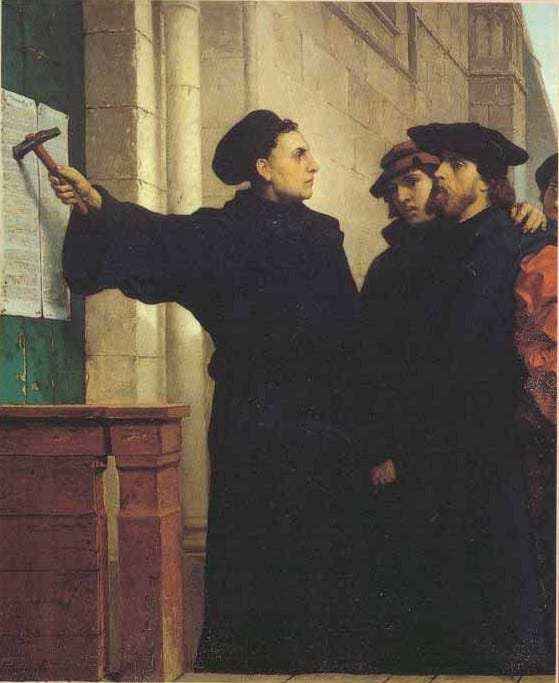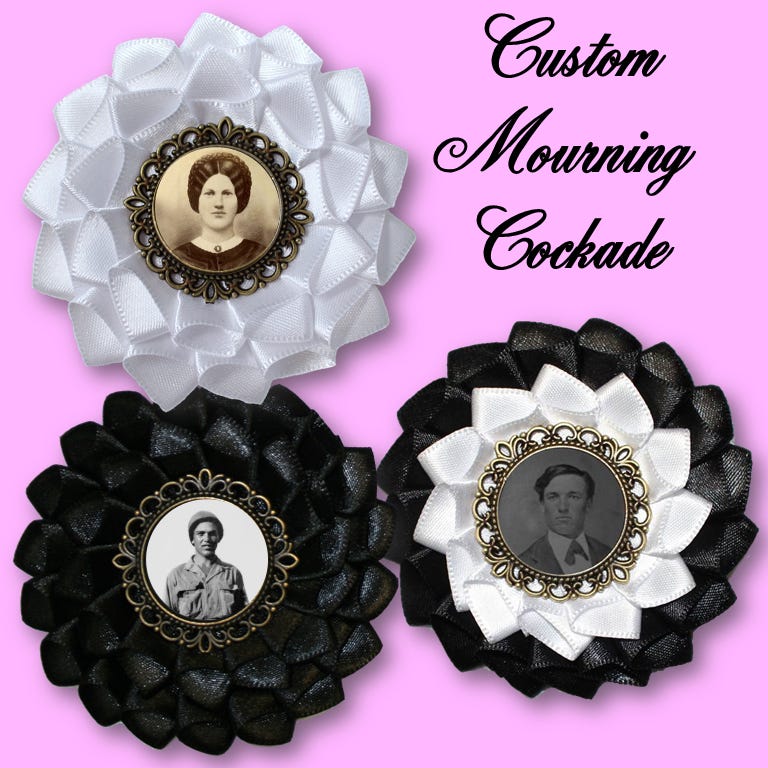Reformation and Cockades
Five hundred and five years ago, a movement began that would change the map of the world - and influence cockades for centuries!
On October 31, 1517 Martin Luther published his Ninety-Five Theses combating the errors of the indulgence system in the Catholic church. This was no mere theological argument among priests - Luther had it translated into the common language (German) and spread among the people.
The Pope and his church hierarchy had accumulated vast power in the world, making and unmaking kings and kingdoms. Along with that power came abuses and immorality. Luther's Theses were the first stroke at the foundation of a massive and corrupt empire.
Beards, Breaths, and Feathers (and Cockades)
One of the sources of income for this political Catholic empire was the sale of indulgences, supposedly the forgiveness of sins for money. Peddlers of these indulgences often displayed phony "relics" - items supposedly belonging to Christ or the Catholic saints. In an 1853 history of the Protestant Reformation, we are told about some of these relics - note the cockade reference!
"At Wittenberg were shown a piece of Noah's ark, a small portion of soot from the furnace of the three young Hebrews, a bit of the manger in which our Savior was laid, a little of the beard of the great Christopher, and nineteen thousand other relics of greater or less value. At Schauffhausen was shown the breath of St. Joseph, which Nicodemus had received into his glove; at Wurtemberg, a dealer in indulgences carried on his head a cockade, containing a large feather from the wing of Michael the archangel! Think you, was it not time for heaven to interpose? Luther appears amid all this to accomplish heaven's behests."
Luther was the catalyst for the Reformation, a movement that insisted the church go back to Scripture alone, without inventions of men.
Reformers, Catholics and Cockades
Catholicism and Protestantism began a struggle that involved not merely the kingdom of God, but also the kingdoms of men. Many a civil war was fought between Catholic and Protestant claimants to the same thrones. And naturally, each side of the conflict usually had its own cockade.
For instance, the Catholic Stuarts wore the white cockade in their quest to gain England's throne and that became the basis for the Scottish white cockade. (Read my blog post about it here.)
The Protestant Dutch William ultimately gained England's throne and brought with him the Dutch orange cockade. That's why Protestant Irish wear orange, while Catholic Irish wear green. (Yep, I've got a blog post on that too.)
Henry VIII established Britain as Protestant for political reasons of his own, but the fracas between Catholic and Protestant didn't end. The Papist Act of 1778, for example, sparked riots that rocked the city of London and were led by anti-government rioters wearing blue cockades. Those blue cockades, by the way, were to appear again several times in American anti-government movements - notably the Nullification Crisis of 1832 and the Secession Crisis of 1860-61. (Aaaand here's the blog post.)
As Protestant and Catholic statesmen boiled along in political disputes, the spiritual Reformation continued. Puritans within the church and Separatists or Non-Conformists outside of the church sought to wean the church from the teachings of men and go back to Scripture alone. But there were persecutions of opposing viewpoints. An account of French Huguenots tells of cockades and a massacre:
Armed bands rushed from Nimes into the country around, ravaged, murdered, or blackmailed the Protestant farmers and small cultivators. Some of the more remote, isolated, and consequently defenceless victims, wishing to find protection, obtained from the Prefet of Alons white flags and cockades. This was done under the eyes of the ' Sous-Prefet ' who, on August 2, gave Graffan the order to march on those very men termed now by that treacherous official 'disguised rebels.' Graffan, proud of this official order, marched forthwith to St. Maurice, seized six men haphazard, brought then triumphantly to the same 'esplanade,' and shot them under the windows of the 'Sous-Prefet,' notwithstanding the protests of the doomed men that they were Royalists and bore the white cockade.
In seeking a way to practice religion according to Scripture instead of the State, many people began looking for a new place to start over. And they found it in the New World. Pilgrims began to arrive in America to create a city on a hill, an example of how practicing biblical religion can create a strong, healthy society.
The Christian foundations of America's history can be traced 500 years back to Martin Luther and his 95 theses. And a long line of cockades marks the trail!
Reformation Day Cockade
The Reformation had its own symbols and cockades, and one that has survived to modern times is Luther's Rose. He himself chose the design and explained it this way in a 1530 letter to a friend:
"Grace and peace from the Lord. As you desire to know whether my painted seal, which you sent to me, has hit the mark, I shall answer most amiably and tell you my original thoughts and reason about why my seal is a symbol of my theology. The first should be a black cross in a heart, which retains its natural color, so that I myself would be reminded that faith in the Crucified saves us. "For one who believes from the heart will be justified" (Romans 10:10). Although it is indeed a black cross, which mortifies and which should also cause pain, it leaves the heart in its natural colour. It does not corrupt nature, that is, it does not kill but keeps alive. "The just shall live by faith" (Romans 1:17) but by faith in the crucified.
"Such a heart should stand in the middle of a white rose, to show that faith gives joy, comfort, and peace. In other words, it places the believer into a white, joyous rose, for this faith does not give peace and joy like the world gives (John 14:27). That is why the rose should be white and not red, for white is the color of the spirits and the angels (cf. Matthew 28:3; John 20:12).
"Such a rose should stand in a sky-blue field, symbolising that such joy in spirit and faith is a beginning of the heavenly future joy, which begins already, but is grasped in hope, not yet revealed.
"And around this field is a golden ring, symbolising that such blessedness in Heaven lasts forever and has no end. Such blessedness is exquisite, beyond all joy and goods, just as gold is the most valuable, most precious and best metal. This is my compendium theologiae [summary of theology]. I have wanted to show it to you in good friendship, hoping for your appreciation. May Christ, our beloved Lord, be with your spirit until the life hereafter. Amen."
Are you ready for upcoming fall events?
Click the captions below to check out items for each event. And feel free to hit me up for custom orders if you don’t see what you need!
Don’t forget that that through the month of October, 10% of my sales will go to help hurricane relief! I sent off a big donation last week and I’m getting ready to send another this week - your shopping helps those in need in a big way. Please continue to keep North Carolina, South Carolina, Tennessee, Georgia and Florida in your prayers as we work to rebuild. It’s been a tough couple of weeks.
And please be sure to shop small businesses - especially those in the hurricane zone - when you do your holiday buying this year! Your purchases may help keep a small business alive. :) Please and thank you!
Forward this to a friend or subscribe if you haven’t! I send out a fun story from cockade history every week.
See you next week!
~Heather
















